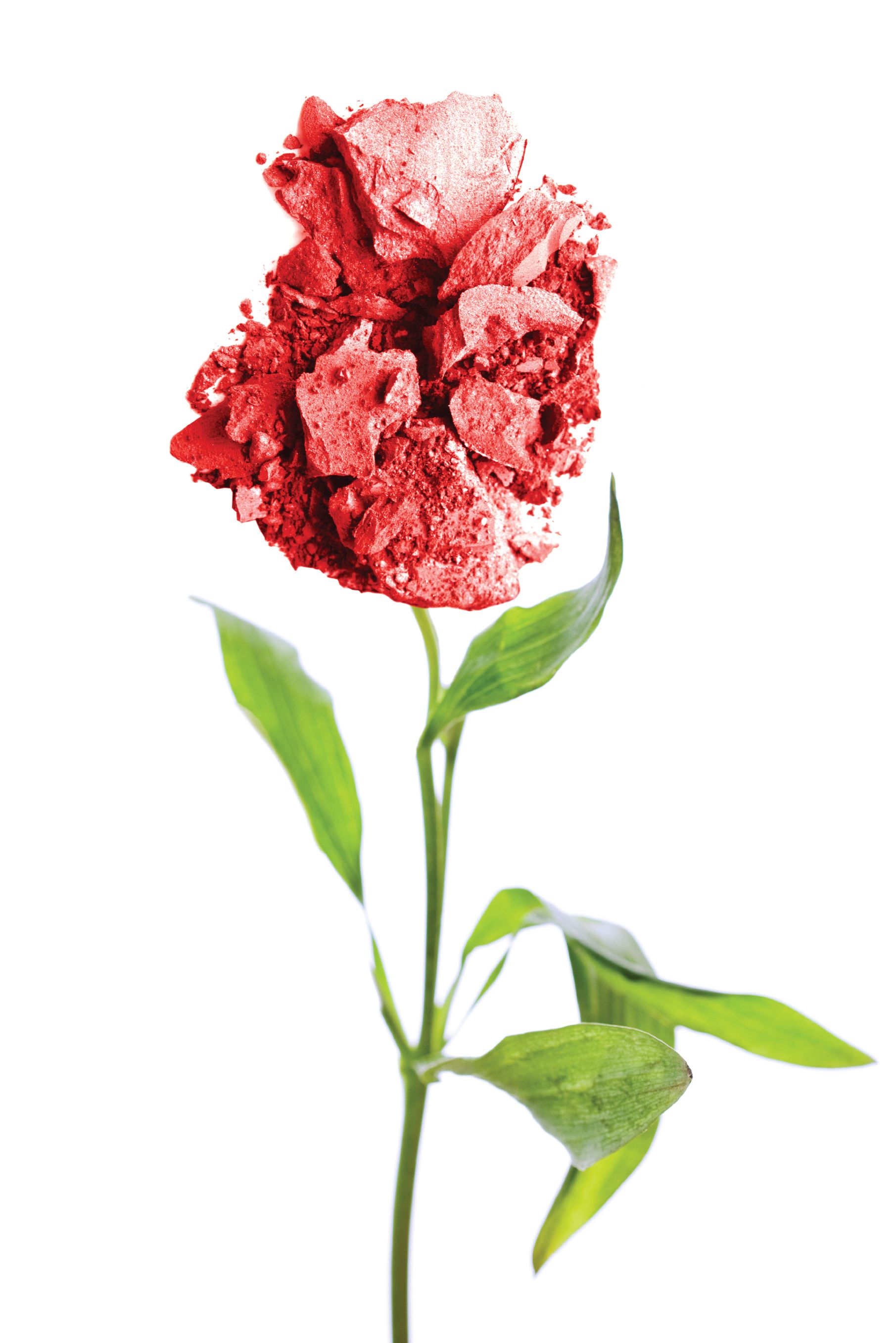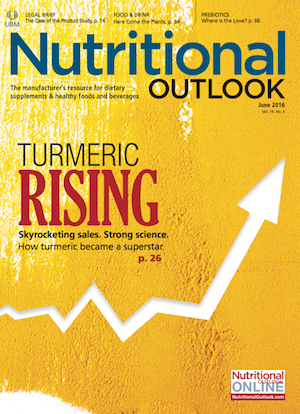Beauty and the Feast: Nutrients for Natural Beauty, Inside and Out
Natural ingredients, both ingestible and topical, are making over today’s beauty products.
Photo © iStockphoto.com/powerofforever

The beauty market is undergoing a facelift as consumers shy away from synthetic ingredients. Beauty brands are now experiencing the same demand for natural ingredients that the food, beverage, and supplement industries are seeing.
Today, both “beauty-from-within” ingestible products and topical skincare and cosmetic products are increasingly formulated with natural, “clean,” and sometimes organic ingredients to address such beauty concerns as cellulite, skin moisture and elasticity, and skin aging. From collagen and melon juice extract to astaxanthin, lutein, and turmeric rhizome derivatives, here are some ingredients currently under the microscope for potential beauty benefits.
Beauty from Within: Ingestible Ingredients
Collagen
The biggest buzz in ingestible beauty formulations seems to center around collagen. Mai Nygaard, global director, Peptan portfolio, for ingredient supplier Rousselot (The Netherlands), cites a February 2015 Global Industry Analysts’ report forecasting that the nutricosmetics market will reach $7.4 billion by 2020, with collagen being one of the market’s most significant drivers. The Asia-Pacific region, the United States, and Brazil are key markets, Nygaard adds.
Rousselot’s own Peptan collagen ingredient has been clinically shown to “restructure the collagen network in deep skin layers,” Nygaard says, basing her comments on a September 2015 study published in the Journal of Cosmetic Dermatology.1 In this study, researchers found that Peptan collagen peptides significantly improved skin hydration after two months of oral supplementation-an effect attributed to the stimulation of hyaluronic acid production, Nygaard says. Peptan can be used in beauty beverages, bars, and gummies.
Another recent collagen study, this time on Verisol collagen peptides from Gelita (Sergeant Bluff, IA), examined collagen’s benefits for cellulite. In the Journal of Medicinal Food,2 researchers concluded that “long-term therapy with orally administered bioactive collagen peptides leads to an improvement of cellulite and has a positive impact on skin health.” Lara Niemann, Gelita’s marketing director, Americas, explains that “over the course of the six-month Verisol supplementation [2.5 g daily], a statistically significant reduction of the cellulite score (‘pinch test’) was observed, starting at three months and appearing more pronounced after six months.” Niemann adds that in three-dimensional skin-surface profile measurements, “skin waviness” was also reduced, and, “remarkably, skin tissue became measurably more dense, indicating a strengthening of the connective tissue.” Verisol collagen, used in both supplements and functional foods and beverages, is highly digestible and bioavailable, and is suitable for allergen-free, gluten-free, and clean-label finished products, she says.
A third collagen supplier, BioCell Technology LLC (Newport Beach, CA), plans to publish new beauty-from-within data related to its ingredient later this year, says president Suhail Ishaq. His company’s BioCell collagen ingredient was the focus of a study published four years ago in Clinical Interventions in Aging3 that concluded that 1000 mg taken daily resulted in skin that appeared less dry and with reduced fine lines and wrinkles in the study’s participants. “Additionally, both collagen levels and blood circulation were improved,” Ishaq says.
STORY CONTINUES ON PAGE 2
Botanicals
Botanical-based ingredients are a perfect fit for natural-minded beauty shoppers. Like collagen, these ingredients continue to turn up in ingestible beauty products.
A relative newcomer to the U.S. market is Bionov’s (Avignon, France) melon juice extract, marketed as cellulite-fighting SOD B Dimpless, suited for capsules, tablets, softgels, instant drinks, gums, candies, and bars. The ingredient is already included in a number of finished food products in Europe, but now it is making its way into U.S. launches, such as ThinkItDrinkIt SOD B Dimpless supplement powder, a neutral-tasting supplement designed for stirring into beverages.
A randomized, double-blind, placebo-controlled clinical study published in October 2015 in the journal Phytothérapie4 saw a significant visual reduction of cellulite on thighs by 9.5% after 28 days of oral supplementation with SOD B Dimpless (40 mg/day, or 480 IU/day). “Clinical efficiency is maintained and even emphasized after 56 days of supplementation, with a significant reduction of cellulite on thighs by 11.3%,” according to Bionov’s press release about the study. Sébastien Le Quéré, Bionov’s product manager, says a new website introducing the ingredient will be launched this summer.
Antioxidants
Astaxanthin, a carotenoid found in algae, is being used in beauty-from-within products to improve skin moisture and elasticity, and to reduce wrinkles. “Studies have shown that oral supplementation with natural astaxanthin provides protection to all layers of the skin,” says Joe Kuncewitch, national sales manager, AstaReal USA, a supplier of astaxanthin. “Natural astaxanthin is the most powerful antioxidant known to science, and it has the ability to optimize the health and radiance of the skin by providing protection and support to all layers. We see this market for both men and women, regardless of skin type, continuing to expand as baby boomers and millennials strive to maintain a healthy, ageless appearance,” Kuncewitch adds. AstaReal astaxanthin is available as an extract oil, a water-soluble extract, and an extract powder. Applications include yogurt, nutritional bars, chocolates, and beverages.
The antioxidant lutein, found naturally in green leafy vegetables, is well known as an eye-health supplement but may also be gaining traction as a beauty-from-within ingredient for skin appearance. Natrol, a vitamin and supplement manufacturer that uses lutein in its formulations, is “acting on clinical research that reveals that the intake of 10 mg of clinical-strength lutein can help to improve skin hydration and elasticity,” according to Michelle Baron, the company’s brand manager of innovation. “It helps protect the skin against visible signs of aging caused by the sun and exposure to the environment.”
Natrol’s new Skin, Hair & Nails supplement contains 10 mg of lutein per pill, along with collagen, hyaluronic acid, biotin, and other antioxidants. “Consumers are paying more attention to the quality of their beauty ingredients and looking for more-natural solutions,” Baron says. “They are more attuned to the fact that what they consume can have a profound effect on how they look and feel.”
MSM
A recent study published in November 2015 in Natural Medicine Journal5 suggests that the ingredient methylsulfonylmethane (MSM), already widely available in joint-health formulations, is useful for improving skin health and appearance when ingested. The randomized, double-blind, placebo-controlled pilot study concluded that supplementation with Bergstrom’s OptiMSM supplements led to significant improvements in skin appearance and condition as evaluated by expert grading, instrumental measures, and participant self-assessment.
“Although the mechanism of action is not well understood,” the study’s authors write, “it is apparent that MSM does work at altering expression of key genes that affect moisturization and barrier function, extracellular matrix production, and inflammation control.” They conclude that “MSM taken orally may be beneficial for skin health and the reduction of fine lines and wrinkles, though further research is warranted in broader populations.”
Rodney Benjamin, director of technical development for Bergstrom Nutrition, says, “As we continue to unlock more information about MSM’s complex mechanism of action, we find that oral supplementation in simplistic terms can modulate the body’s oxidative and inflammatory status. As the study suggests, this can help protect the skin from premature aging by reducing fine lines and wrinkles and improving texture. This application is true ‘beauty from within.’”
STORY CONTINUES ON PAGE 3
From the Outside In: Natural Ingredients for Topical Beauty
Ingredients derived from nature, such as eggshell membrane, probiotics, collagen, and botanicals, are trending in the topical-beauty-products space. Biova’s (Johnston, IA) BiovaDerm ingredient, for instance, is derived from water-soluble egg membrane and contains collagen, elastin, desmosine, isodesmosine, and glycosaminoglycans. This combination reduces the appearance of fine lines and wrinkles, the company says, and “recent in vitro studies [of the product] have documented the expression of critical skincare nutrients,” according to Biova’s president, Matt Stegenga. Of the ingredient’s studies now completed and being prepared for publication, he says “one piece of data we can share is that one study confirmed our previous open-label findings, which support the reduction of the appearance of fine lines and wrinkles within weeks [when the BiovaDerm product is topically applied]. While still emerging, this ingredient shows tremendous promise of becoming the next skincare powerhouse.”
Probiotics company Ganeden Biotech (Cleveland) recently announced the inclusion of its Bonicel ingredient in GundryMD’s new topical product, Correct + Calm Redness Relief Cream, which also includes peptides, tiger grass stem cells, and myrrh. Bonicel, introduced by Ganeden in 2012, is the trademarked name of the supernatant produced during the fermentation of the firm’s flagship GanedenBC30 (Bacillus coagulans GBI-30, 6086) shelf-stable probiotic ingredient.
Bonicel itself is not a probiotic, but a probiotic derivative. Mike Bush, senior vice president, Ganeden, calls Bonicel “the first science-backed probiotic-derived skincare ingredient shown to significantly improve the appearance of seven common signs of aging and is optimized to contain the perfect combination of naturally derived metabolites.” Those seven signs of aging are fine lines and wrinkles, enlarged pore size, redness, roughness, dryness, and decreased elasticity. Bush also shares that in a not-yet-published gene-regulation full-thickness skin-model study, Bonicel was found to increase the expression of a gene relating to collagen production. This, he says, provides further support for the claim that Bonicel may have skin-firming and anti-wrinkle activity.
The ingredient has been used in a variety of topical applications, including Murad and Healthy Directions skincare products, and can be incorporated into lotions, creams, soaps, shampoos, and other personal-care products.
Shaheen Majeed, marketing director for Sabinsa Corp. (East Windsor, NJ), a manufacturer, supplier, and marketer of herbal extracts, cosmeceuticals, minerals, and dietary supplements, calls the topical use of probiotics “an interesting new trend with incredible potential.” He says the company’s LactoSpore shelf-stable probiotic is being incorporated into soaps, bath salts, haircare products, and creams.
Majeed also singles out Sabinsa’s SabiWhite ingredient, a colorless natural extract derived from turmeric (Curcuma longa) rhizomes, as demonstrating clinical potential for hyperpigmentation disorders. “Tetrahydrocurcumin is one of the major metabolites of curcumin,” Majeed says. “This is valued as a topical antioxidant and anti-inflammatory agent with superior free-radical scavenging and lipid-peroxidation-inhibition efficacy as compared to vitamin E.” Demand for this ingredient is high in Southeast Asia, Majeed adds.
Also read:
In case you missed our June 9th, 2016, webcast, "Natural Beauty Ingredients, Inside and Out," you can watch it on-demand. Learn about the latest trends and ingredient research around the globe for natural beauty products, both topical and ingestible: www.nutritionaloutlook.com/no/natural
U.S. Leads World in Hemp Food, Beauty Sales
Collagen's Best Bet for Reaching New Markets
Slideshow: Nutricosmetic Ingredients on the Rise
References:
- Assarin J et al. “The effect of oral collagen peptide supplementation on skin moisture and the dermal collagen network: evidence from an ex vivo model and randomized, placebo-controlled clinical trials,” Journal of Cosmetic Dermatology, vol. 14, no. 4 (December 2015): 291-301
- Schunck M et al., “Dietary supplementation with specific collagen peptides has a body mass index-dependent beneficial effect on cellulite morphology,” Journal of Medicinal Food, vol. 18, no. 12 (December 2015): 1340-1348
- Schwartz SR et al., “Ingestion of BioCell Collagen(®), a novel hydrolyzed chicken sternal cartilage extract; enhanced blood microcirculation and reduced facial aging signs,” Clinical Interventions in Aging. Published online July 27, 2012.
- Lemaire B et al., “Ãtude clinique d’une SuperOxide Dismutase de melon naturelle et bioactive (SOD B Dimpless®) sur la cellulite,” Phytothérapie, vol. 14, no. 1 (February 2016): 23-28
- Anthonavage M et al., “Effects of oral supplementation with methylsulfonylmethane on skin health and wrinkle reduction; a randomized, placebo-controlled, double-blind clinical pilot study on OptiMSM,” Natural Medicine Journal, vol. 7, no. 11 (November 2015)
